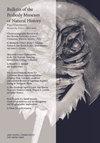Postcranial Skeletal Variation in Pencil-Tailed Tree Mice (Rodentia: Muridae: Chiropodomys): Functional, Ecogeographic, and Taxonomic Implications
IF 0.9
4区 哲学
Q2 BIODIVERSITY CONSERVATION
引用次数: 0
Abstract
Abstract Pencil-tailed Tree Mice (Muridae: Chiropodomys) are small arboreal mammals endemic to the rainforests of Southeast Asia. They are capable of manual and pedal grasping and have nails rather than claws on their pollex and hallux, but their limb morphology has never been analyzed from functional, ecogeographic, or taxonomic perspectives. We compared two species of Chiropodomys to the similarly sized but terrestrial Mus musculus using quantitative morphometric osteological data recorded from six limb bones. Principal components analysis (PCA) clearly separated Chiropodomys from Mus. Multivariate and univariate analyses revealed several features linked to arboreality in Chiropodomys and characteristics associated with terrestriality in Mus. These include a wide medial epicondyle and shallow knee in Chiropodomys and a long olecranon process, long greater trochanter, and deep knee in Mus. PCA also distinguished mainland C. gliroides from island C. calamianensis of the Palawan Faunal Region, with the latter exhibiting larger body size, as predicted by the island rule. Finally, PCA clearly separated northeastern C. gliroides specimens collected north of the Isthmus of Kra from southwestern specimens collected on the Malay Peninsula south of the Isthmus of Kra; these preliminary results may indicate that there are two distinct taxa in this sample, but this must be tested with more specimens and data. Overall, our study revealed functional differences related to substrate preference, larger body size in an island endemic species, and postcranial evidence for an additional mainland taxon.铅笔尾树鼠(啮齿目:鼠科:足鼠科)的颅后骨骼变异:功能、生态地理和分类学意义
摘要铅笔尾树鼠(鼠科:Chiropomys)是东南亚热带雨林特有的小型树栖哺乳动物。它们能够手动和脚踏抓握,花粉和拇趾上有指甲而不是爪子,但它们的肢体形态从未从功能、生态地理或分类学的角度进行过分析。我们使用从六块肢体骨骼记录的定量形态计量骨学数据,将两种Chiropomys与大小相似但陆地上的Mus musculus进行了比较。主成分分析(PCA)清楚地将Chiropodomys与Mus区分开。多变量和单变量分析揭示了与Chiropodomys的树木性有关的几个特征以及与Mus的陆地性有关的特征。其中包括Chiropomys的宽内侧上髁和浅膝,Mus的长鹰嘴突、长大转子和深膝。PCA还将大陆灰蝶与巴拉望动物区的炉甘石岛灰蝶区分开来,后者的体型更大,正如岛屿规则所预测的那样。最后,主成分分析清楚地将在克拉地峡以北采集的东北方的C.gliroides标本与在克拉地峡以南的马来半岛采集的西南部标本区分开来;这些初步结果可能表明,在这个样本中有两个不同的分类群,但这必须用更多的标本和数据来检验。总的来说,我们的研究揭示了与底物偏好、岛屿特有物种较大体型以及其他大陆分类单元的颅后证据有关的功能差异。
本文章由计算机程序翻译,如有差异,请以英文原文为准。
求助全文
约1分钟内获得全文
求助全文
来源期刊

Bulletin of the Peabody Museum of Natural History
BIODIVERSITY CONSERVATION-ECOLOGY
CiteScore
2.40
自引率
0.00%
发文量
6
审稿时长
>12 weeks
期刊介绍:
The Bulletin of the Peabody Museum of Natural History publishes original research based on specimens, artifacts and related materials maintained in the collections of the Yale Peabody Museum of Natural History’s curatorial divisions. The Bulletin is published twice a year, in April and October.
 求助内容:
求助内容: 应助结果提醒方式:
应助结果提醒方式:


